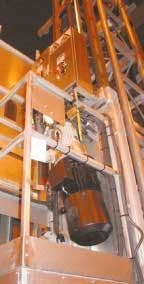Original Buchan lifts refurbished with little disruption to field operations
Since the mid-1970s, Alimak passenger elevators have been providing access to offshore personnel from the deck level down each of the five legs of the Buchan Alpha Pentagon-design platform in the UK North Sea. Originally, the elevators were expected to have a working life of 15-20 years. Following operator Talisman Energy's decision two years ago to invest heavily in an extension of their operations on the Buchan field, a contract worth over $1.4 milion was placed with Intervect UK, covering major refurbishment of all five Alimak elevators.
Intervect is a Swedish holding company with engineering subsidiaries around the world. These include Alimak, the group's OEM arm, which is designing, manufacturing, and testing all the equipment at its dedicated plant in Skellefteå, northern Sweden. The elevator cars and structural back frames are fully assembled, wired, and tested. Talisman's agent also undertook inspection at the plant – an unusual procedure for an oil company client, according to Alimak. Completed cars or major sub-assemblies will remain in a built-up condition when delivered to the platform, to minimize the lifting and installation time.
The Buchan platform remains in constant use, despite the rolling program of modernization affecting a variety of equipment onboard, including accommodation, cranes, and elevators. The challenge facing Intervect UK is to replace the elevators to an agreed sequence aimed at minimizing disruption to Talisman's operations, while still providing adequate access for safety. The elevators are used for essential access by personnel and for the removal of compact but heavy equipment such as pumps and valves.
In recent times, elevator design and shaft construction, access, and safety requirements have undergone radical reform, placing higher demands on owners and suppliers to meet more stringent safety codes and engineering standards. In Buchan's case, the new EN-81 European guideline for elevator installation, together with relevant UK Health and Safety Legislation, must both be correctly interpreted, with practical solutions determined and the work harmonized to satisfy the codes, product certification, and independent certification of the finished installation upon final commissioning.
One particular challenge facing Alimak was to supply new equipment of modern design into the restricted dimensions determined by the original installation completed in 1976, while still meeting the current rules on safe working areas. A special range of Alimak drive units and couplings enabled the motors and gearboxes to be inclined from the vertical, to reduce their plan footprint and to be kept within the confines of the elevator shaft.
null
Alimak and Intervect's offshore technical support staff together surveyed the existing lifts, shafts, fixing points, and access routes, prior to submitting their pre-engineered proposals for the project. This also enabled method statements and risk assessments to be developed for Talisman's team to use in their mechanical, electrical site preparation and enabling works. A program was drawn up to replace two elevators in the columns most frequently operated, followed by the final three units in phased completions.
Talisman's performance specification has been incorporated into the design of these elevators. All safety-critical components will be tested off site, with Talisman's representatives inspecting and witnessing this certification process. In addition to their own equipment and offshore operations, Intervect's project management team will help guide and monitor the progress of, supplementary safety screens, lighting, guarding, and other third-party engineering work needed to comply with EN-81.
With the removal of the first elevator to form a void, the usual installation method to install the replacement elevator first requires scaffolding the shaft to gain access. This is time consuming, costly, and difficult in a restricted space. Intervect's solution was to use the original lift car, modifying it into a bespoke "installation-working platform" complete with purpose-designed drive and brake units. The old elevator car was returned to Intervect UK's engineering workshop, which is equipped for fast-track fabrication and testing. The car cabin was removed and steelwork added to form a new and safe working platform. When returned to the platform, this was then used running on the newly refurbished guide rails, to assist with the installation of elevator wiring and shaft ancillary equipment. Afterwards, it was returned to the client's shore base for temporary storage, ready for re-use for the next lift. This solution saved the client significant expense and time on the project.
Intervect will also remove the original elevator's structural supporting mast, completely refurbish it, apply the latest hot dipped galvanizing techniques and replace the units ahead of the new elevator installation. The contract is due to be completed during 2005, followed by a separate contract of rolling maintenance and inspection.
For more information contact Steve Williams, Alimak. Tel: +44 1527 879279, Fax: +44 1527 879279, [email protected], www.alimak.com

